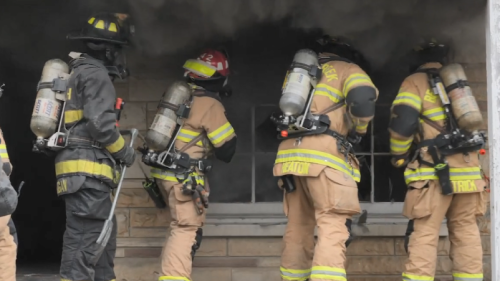Fireground operations center on the ability to make quick, effective decisions under pressure, especially when it comes to ventilation. When you have firefighters entering a structure to make an interior attack, ventilation becomes a priority. After all, research shows that the strategic removal of heat, smoke and toxic fire gases from a burning structure can dramatically improve the safety and efficiency of bringing the fire under control.
The problem: Many departments simply do not have the appropriate level of staffing to commit a truck company to the roof for ventilation, particularly when other truck company operations like search and rescue or laddering the building take priority. Many departments, especially volunteer and combination organizations, face the reality of doing more with less, so we must identify other options to perform ventilation.
Cross-training crewmembers
Ventilation’s primary goal is to create a safer environment inside the structure for firefighters and possible victims by improving visibility and removing highly flammable fire gases. When the element of limited staffing is introduced, the challenges grow, requiring crews to be cautious in their use of resources. Incident commanders must prioritize tasks, like fire control, search and rescue, and ventilation, allowing for the allocation of resources in such a manner that maximizes impact without compromising firefighter safety.
To start, it is essential that ICs have a clear understanding of each firefighter’s skills. When crews arrive at the fire scene, versatility is key; firefighters must be prepared to perform multiple roles when required. This can be anything from operating the pump to completing ventilation and conducting search and rescue. Working to cross-train members becomes an essential component of preparation, ensuring each crewmember can contribute effectively across a wide range of fireground tasks.
Preparing people and tools
As simple as it may sound, preparation really is the foundation of effective fireground operations, more so in departments that are facing limited staffing. For example, a well-detailed pre-incident plan of a commercial building that contains an updated floorplan and list of potential hazards will help crews identify the most effective ventilation strategies in advance of an incident at that location.
Another key is regular training sessions that are focused on real-world scenarios. Such training should be conducted with limited staffing in mind to best simulate real-world conditions. These drills should focus on developing rapid, efficient ventilation techniques, ensuring every firefighter is proficient at using tools and equipment under pressure. This includes every item that will be used – ladders, saws and hand tools – plus how to operate portable radios in firefighter turnout gear. Sometimes the smallest piece of your gear will cause the biggest issue.
It’s also vital to ensure the readiness of all the equipment required for ventilation. Ensuring that every tool is ready to go to work is simply non-negotiable. Daily maintenance checks and recurring equipment drills ensure that when the time comes, operations aren’t hampered by mechanical failures. Remember: Equipment drills can be as straightforward as how to quickly change a chain on the roof saw. Crewmembers must master all task-level skills.
Horizontal vs. vertical ventilation
Adapting ventilation techniques to accommodate limited staffing involves making strategic choices between horizontal and vertical ventilation, prioritizing efficiency and safety at every turn. The decision between horizontal and vertical ventilation will be determined by each unique situation. Elements like the fire’s location and behavior, the building layout and design, and firefighter safety all should be taken into consideration.
- Horizontal ventilation can often be initiated more quickly and with fewer personnel. Opening windows for cross ventilation, which can be done very fast with only a couple firefighters, could be a good choice.
- Positive pressure ventilation (PPV) to force air into the building, replacing the smoke and fire gases, may be the best option for an incident where the location of the fire is known and contained. The PPV can quickly remove the smoke and fire gases, increasing visibility for interior operations.
- Vertical ventilation, though potentially more effective in certain scenarios, requires careful consideration due to the increased risk and staffing demands. Always remember that putting crewmembers on the roof is very risky and should be only done by members who have trained extensively on this task.
Seeking outside help
It should be noted that staffing issues must be communicated to your community, including city officials. If they don’t know what you are experiencing – and that you have to choose which tasks to perform – how will they know how to help?
One way the community might be able to help is through the adoption of a new fire code. For example, the department could push for the adoption of new technological aids like automatic vent covers. These can be pre-installed in buildings and integrated into smart building systems, which would allow for automatic venting of high heat or smoke concentration in conjunction with fire sprinklers.
But where to begin? Once a need is identified, the department would draft a revision to the current code and seek out stakeholder support, working with homeowners’ associations or community groups. After gaining their backing, the fire marshal would then submit to the local governing body for approval and implementation. Having items like this built into the fire protection system assists firefighters long before they even arrive on the scene.
Final thoughts
The challenges of limited staffing on the fireground, and specifically in ventilation efforts, are significant but not impossible. Through good planning and preparation, departments can overcome these difficulties. Training, adaptability and a solid understanding of fire and smoke behavior are essential so crews can perform effectively and safely, no matter their size.
Be prepared. Be safe. Train hard!








